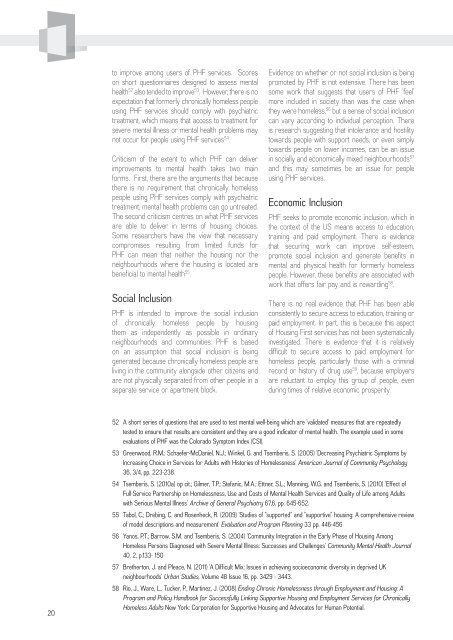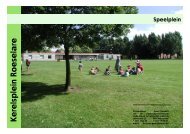Housing First - Provincie West-Vlaanderen
Housing First - Provincie West-Vlaanderen
Housing First - Provincie West-Vlaanderen
Create successful ePaper yourself
Turn your PDF publications into a flip-book with our unique Google optimized e-Paper software.
to improve among users of PHF services. Scoreson short questionnaires designed to assess mentalhealth 52 also tended to improve 53 . However, there is noexpectation that formerly chronically homeless peopleusing PHF services should comply with psychiatrictreatment, which means that access to treatment forsevere mental illness or mental health problems maynot occur for people using PHF services 54 .Criticism of the extent to which PHF can deliverimprovements to mental health takes two mainforms. <strong>First</strong>, there are the arguments that becausethere is no requirement that chronically homelesspeople using PHF services comply with psychiatrictreatment, mental health problems can go untreated.The second criticism centres on what PHF servicesare able to deliver in terms of housing choices.Some researchers have the view that necessarycompromises resulting from limited funds forPHF can mean that neither the housing nor theneighbourhoods where the housing is located arebeneficial to mental health 55 .Social InclusionPHF is intended to improve the social inclusionof chronically homeless people by housingthem as independently as possible in ordinaryneighbourhoods and communities. PHF is basedon an assumption that social inclusion is beinggenerated because chronically homeless people areliving in the community alongside other citizens andare not physically separated from other people in aseparate service or apartment block.Evidence on whether or not social inclusion is beingpromoted by PHF is not extensive. There has beensome work that suggests that users of PHF ‘feel’more included in society than was the case whenthey were homeless, 56 but a sense of social inclusioncan vary according to individual perception. Thereis research suggesting that intolerance and hostilitytowards people with support needs, or even simplytowards people on lower incomes, can be an issuein socially and economically mixed neighbourhoods 57and this may sometimes be an issue for peopleusing PHF services.Economic InclusionPHF seeks to promote economic inclusion, which inthe context of the US means access to education,training and paid employment. There is evidencethat securing work can improve self-esteem,promote social inclusion and generate benefits inmental and physical health for formerly homelesspeople. However, these benefits are associated withwork that offers fair pay and is rewarding 58 .There is no real evidence that PHF has been ableconsistently to secure access to education, training orpaid employment. In part, this is because this aspectof <strong>Housing</strong> <strong>First</strong> services has not been systematicallyinvestigated. There is evidence that it is relativelydifficult to secure access to paid employment forhomeless people, particularly those with a criminalrecord or history of drug use 59 , because employersare reluctant to employ this group of people, evenduring times of relative economic prosperity.2052 A short series of questions that are used to test mental well-being which are ‘validated’ measures that are repeatedlytested to ensure that results are consistent and they are a good indicator of mental health. The example used in someevaluations of PHF was the Colorado Symptom Index (CSI).53 Greenwood, R.M.; Schaefer-McDaniel, N.J.; Winkel, G. and Tsemberis, S. (2005) ‘Decreasing Psychiatric Symptoms byIncreasing Choice in Services for Adults with Histories of Homelessness’ American Journal of Community Psychology36, 3/4, pp. 223-238.54 Tsemberis, S. (2010a) op cit.; Gilmer, T.P.; Stefanic, M.A.; Ettner, S.L.; Manning, W.G. and Tsemberis, S. (2010) ‘Effect ofFull-Service Partnership on Homelessness, Use and Costs of Mental Health Services and Quality of Life among Adultswith Serious Mental Illness’ Archive of General Psychiatry 67,6, pp. 645-652.55 Tabol, C.; Drebing, C. and Rosenheck, R. (2009) ‘Studies of “supported” and “supportive” housing: A comprehensive reviewof model descriptions and measurement’ Evaluation and Program Planning 33 pp. 446-45656 Yanos, P.T.; Barrow, S.M. and Tsemberis, S. (2004) ‘Community Integration in the Early Phase of <strong>Housing</strong> AmongHomeless Persons Diagnosed with Severe Mental Illness: Successes and Challenges’ Community Mental Health Journal40, 2, p.133- 15057 Bretherton, J. and Pleace, N. (2011) ‘A Difficult Mix: Issues in achieving socioeconomic diversity in deprived UKneighbourhoods’ Urban Studies, Volume 48 Issue 16, pp. 3429 - 3443.58 Rio, J., Ware, L., Tucker, P., Martinez, J. (2008) Ending Chronic Homelessness through Employment and <strong>Housing</strong>: AProgram and Policy Handbook for Successfully Linking Supportive <strong>Housing</strong> and Employment Services for ChronicallyHomeless Adults New York: Corporation for Supportive <strong>Housing</strong> and Advocates for Human Potential.
















